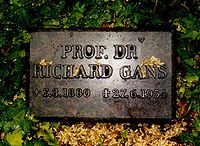
Richard Gans
Encyclopedia

Hamburg
-History:The first historic name for the city was, according to Claudius Ptolemy's reports, Treva.But the city takes its modern name, Hamburg, from the first permanent building on the site, a castle whose construction was ordered by the Emperor Charlemagne in AD 808...
, was the physicist who founded the Physics Institute of the National University of La Plata
Universidad Nacional de La Plata
The National University of La Plata is one of the most important Argentine national universities and the biggest one situated in the city of La Plata, capital of Buenos Aires Province...
, Argentina
Argentina
Argentina , officially the Argentine Republic , is the second largest country in South America by land area, after Brazil. It is constituted as a federation of 23 provinces and an autonomous city, Buenos Aires...
. He was its Director in two different periods.
During the first one, starting in 1911, he continued the work started by Emil Bose
Emil Bose
Emil Hermann Bose , German physicist, was the first teacher in the Physics Department at the University of La Plata, Argentina. He studied under Nernst and was recruited by the newly created university in Argentina, where he taught for two years until his death from typhoid fever in 1911. He was...
raising the research level of the institute to international renown. In 1914 he founded the publication of a scientific journal: Contribución al estudio de las ciencias fisicomatemáticas, with two series: matematicofísica and técnica.
His second period in La Plata was from the late 1940s through the early 1950s when he played an important role as member of one of the commissions which reviewed Ronald Richter
Ronald Richter
Ronald Richter was an Austrian, later Argentine, scientist who became famous in connection with the Huemul Project and the National Atomic Energy Commission. This was intended to generate energy from nuclear fusion in the 1950s in Argentina, during the presidency of Juan Perón...
's claims related to the Huemul Project
Huemul Project
The Huemul Project was a secret project proposed by the German scientist of Austrian origin Ronald Richter to the government of Argentina during the first presidency of Juan Domingo Perón....
.
After leaving La Plata in 1951 he taught theoretical and advanced physics at the University of Buenos Aires
University of Buenos Aires
The University of Buenos Aires is the largest university in Argentina and the largest university by enrollment in Latin America. Founded on August 12, 1821 in the city of Buenos Aires, it consists of 13 faculties, 6 hospitals, 10 museums and is linked to 4 high schools: Colegio Nacional de Buenos...
.
Gans theory
Gans theory
Gans theory or Mie-Gans theory is the extension of Mie theory for the case of spheroidal particles. It gives the scattering characteristics of both oblate and prolate spheroidal particles much smaller than the excitation wavelength....
is named after Richard Gans. This theory gives the solutions to the Maxwell equations for prolate and oblate spheroidal particles. It is an extension of Mie theory
Mie theory
The Mie solution to Maxwell's equations describes the scattering of electromagnetic radiation by a sphere...
and thus sometimes called Mie-Gans theory. He first published these equations describing the scattering of elongated particles in 1912 for gold particles. In 1915, the solution for silver particles was published.
Studies
Gans graduated in 1901, summa cum laude, with the title of Dr.Phil.Nat. at the University of StrasbourgUniversity of Strasbourg
The University of Strasbourg in Strasbourg, Alsace, France, is the largest university in France, with about 43,000 students and over 4,000 researchers....
.
Academic timeline
- 1901-02 University of Heidelberg
- 1903-11 University of Tübingen
- 1911-12 University of StrasbourgUniversity of StrasbourgThe University of Strasbourg in Strasbourg, Alsace, France, is the largest university in France, with about 43,000 students and over 4,000 researchers....
- 1912-25 Universidad de La Plata
- 1925-35 University of KönigsbergUniversity of KönigsbergThe University of Königsberg was the university of Königsberg in East Prussia. It was founded in 1544 as second Protestant academy by Duke Albert of Prussia, and was commonly known as the Albertina....
- Interrupted: 3rd Reich, WWII, postwar -
- 1947-51 Universidad de La Plata
- 1951-53 Universidad de Buenos Aires

